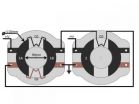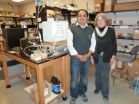(Press-News.org) CHAMPAIGN, Ill. — Like any other newborn, the neonatal horse can be a challenging patient. Its immune system is still under construction, its blood chemistry can vary wildly, and – like most infants – it wants to stay close to mom.
These factors are magnified in the critically ill foal, said Pamela Wilkins, a professor of equine internal medicine and emergency/critical care at the University of Illinois and the author of a new paper on equine neonatal intensive care.
The paper, in Clinical Laboratory Medicine, offers guidance to the large-animal veterinarian and demonstrates the very real challenges of the job.
Sickness can play havoc with a foal's blood chemistry, Wilkins said. Teasing out the causes of these changes requires that the veterinarian first understand what is normal in a newborn horse, and then how it can go wrong. To help address current gaps in knowledge, Wilkins regularly conducts blood tests or other tests, such as X-rays and CT scans, on healthy foals to determine how their body chemistry or physiology differ from that of an adult horse – or from that of a sick foal.
"Roughly 3 to 7 percent of newborn foals are going to have some kind of significant health issue in the first month of life," Wilkins said.
"And because our patients can't talk to us, we have to figure out what's wrong with them based on physical examination and testing and histories given by their owners."
The paper also offers guidance in the use of portable "point of care" devices to measure and monitor a sick foal's changing health status. Such tools can offer immediate results in the field and cut costs associated with care. But the practitioner needs to know how use each device and interpret the results, Wilkins said.
"For example, foals with severe infections can have a very, very low or a very high glucose level," she said. Low blood glucose could be the result of the foal not taking in enough nutrients from its mother. Or the animal may not be able to make use of the glucose that is already stored as glycogen in its body. It's the practitioner's job to find out what's going on, she said.
To do that, veterinarians must understand the normal fluctuations in levels of glucose and other "biomarkers" of health or disease, Wilkins said.
"Blood glucose levels are going to be different between the normal, healthy adult horse and the healthy foal," she said. "And they're going to be different at different stages of the foal's life." Hormones, immune cells, red blood cells, protein levels, enzymes and electrolytes all vary between the adult and the infant horse, Wilkins said. And many of these markers change as the foal matures and grows.
The challenges of treating a sick foal doesn't end there, she said. A horse, even a foal, is a big, precocious animal.
"Horses are a prey species, so they have to be able to get on their feet and run pretty quickly after birth," she said. "The older and slower I get, the harder it is to approach them. You spend a lot of time on your knees dealing with them, and they can kick. I get bruises all over my body during foaling season and I have no idea where they're from because I'm focused on what I'm doing."
Add a very protective mother to the equation, and the task gets even trickier.
"The mom needs to be there," Wilkins said. "She gets really upset if she's not."
So when a foal comes into the hospital for critical care, the mother comes too. And like any mother with a sick baby, she hovers.
"Figuring out a way to keep mom from pulling the IV lines out and getting upset when you're between her and the baby, that takes some doing," Wilkins said. "The mothers don't sleep; they don't lie down; they don't rest. They're on their feet with their heads hanging over their babies most of the time. So it's tough for them."
If a foal needs surgery, the medical staff will sedate the mom until the foal is back at her side.
Wilkins' patients may be the progeny of racehorses or performance horses, but many are also just people's pets, she said. The cost of care can be high, so owners with a strong economic or emotional incentive are most likely to bring a critically ill foal to the hospital.
Despite the many challenges, Wilkins loves the work.
"Foals are just wonderful, wonderful creatures," she said. "I can't imagine working with anything else in my life."
INFORMATION:
Editor's notes: To reach Pamela Wilkins, email pawilkin@illinois.edu.
The paper, "The Equine Neonatal Intensive Care Laboratory: Point-of-Care Testing," is available online or from the U. of I. News Bureau.
Treating newborn horses: A unique form of pediatrics
2011-04-07
ELSE PRESS RELEASES FROM THIS DATE:
Recovery Slow for Arizona's Stressed Economy
2011-04-07
In spite of the fact that the number of new bankruptcy filings actually fell for several straight months in 2010, the year still resulted in a record number of filings -- nearly 30,000 in all -- in the Phoenix metro area. That is higher than financial industry experts initially forecast and shows that much of Arizona's economy is still in recession mode. The new record is nearly 5,000 filings more than the previous one set back in 2005 (as thousands tried to take advantage of lax bankruptcy rules before sweeping changes took effect in October of that year).
The high ...
Replacing batteries may become a thing of the past, thanks to 'soft generators'
2011-04-07
Battery technology hasn't kept pace with advancements in portable electronics, but the race is on to fix this. One revolutionary concept being pursued by a team of researchers in New Zealand involves creating "wearable energy harvesters" capable of converting movement from humans or found in nature into battery power.
A class of variable capacitor generators known as "dielectric elastomer generators" (DEGs) shows great potential for wearable energy harvesting. In fact, researchers at the Auckland Bioengineering Institute's Biomimetics Lab believe DEGs may enable light, ...
Common nanoparticles found to be highly toxic to Arctic ecosystem
2011-04-07
Queen's researchers have discovered that nanoparticles, which are now present in everything from socks to salad dressing and suntan lotion, may have irreparably damaging effects on soil systems and the environment.
"Millions of tonnes of nanoparticles are now manufactured every year, including silver nanoparticles which are popular as antibacterial agents," says Virginia Walker, a professor in the Department of Biology. "We started to wonder what the impact of all these nanoparticles might be on the environment, particularly on soil."
The team acquired a sample of soil ...
Common Safety Myths Can Cause More Harm than Good to Motorcyclists
2011-04-07
There are many misunderstandings circulating about the best ways for motorcycle riders to avoid being involved in accidents with other cars. In some cases, these myths about motorcycle accidents can do more harm than good -- and put motorcyclists' lives at risk.
Motorcycle riders are eight times more likely than those in passenger vehicles to be seriously injured in an accident and 35 times more likely to die in an accident. With these statistics in mind, it is important for motorcyclists to know the best ways to protect their safety - and what legal options they have ...
Micro aircraft IMPULLS improves avionic systems and sensors
2011-04-07
A novel test aircraft of the TU Muenchen successfully completed its maiden flight yesterday at the airfield of the MFC Red Baron near Heimstetten. The micro aircraft christened "IMPULLS" (Innovative Modular Payload UAV – TUM LLS) will facilitate testing aviation sensors and systems. It was jointly developed by postgraduate students at the Institute of Aircraft Design and the Institute of Flight System Dynamics in Garching. Propelled by a compact electric motor, the aircraft flies quietly and free of emissions.
A particularly important feature of the novel design is its ...
Bronx Bus Accident Claims 15 NYC Lives, Negligent Hiring Suspected
2011-04-07
Witnesses to a recent fatal bus crash in the Bronx told law enforcement that the bus was veering erratically before flipping onto one side and striking a sign post. The post sliced through the passenger compartment almost to the rear of the vehicle, creating horrific carnage in the passenger area and nearly removing the roof. The bus was returning from a Connecticut casino to Chinatown in Manhattan when the accident occurred early on a Saturday morning, just after the bus entered the Bronx from Westchester County.
A host of reports soon after indicated that the driver, ...
Seeing rice with X-rays may improve crop yields
2011-04-07
College Park, Md. (April 6, 2011) -- Most people experience X-ray computed tomography (CT) scanners when they are evaluated for a suspected tumor or blood clot. But in the lab of Dr. Quin Liu, PhD., in Wuhan China, rice plants were the patients in a novel use of CT scanners as part of an agriculture study to increase rice yield.
Into the CT scanner on a conveyor belt went little potted rice plants in an automated facility that could process 4,320 rice plants a day. The non-invasive CT energy analyzed tissues and matched their traits against a computer program to aid ...
Malpractice Case Highlights Expert Testimony Disclosure in Connecticut
2011-04-07
When it comes to arguing and proving medical malpractice claims at trial, providing strong expert testimony to support these cases is crucial. The Supreme Court of Connecticut recently decided a case, Klein v. Norwalk, which highlights this important tactic, as well as the standard for disclosing what points an expert will make during testimony. Although this case had a long and difficult journey through multiple Connecticut courts, and continues to make waves, the Connecticut Supreme Court made Klein v. Norwalk a noteworthy opinion.
Klein's Claim
According to the ...
Here's looking at you!
2011-04-07
CORAL GABLES, FL (April 6, 2011)—Learning how babies communicate can teach us a lot about the development of human social interactions. Psychologist Daniel Messinger, from the University of Miami (UM), studies infants' interactions and has found that babies are not simply living in the moment. Instead, infants seem to have particular interests that create historical footprints reflected in the infants' visual engagement over time. The findings were published today, in a study titled, 'Are You Interested, Baby?' Young Infants Exhibit Stable Patterns of Attention during Interaction." ...
New device promises safer way to deliver powerful drugs
2011-04-07
College Park, Md. (April 6, 2011) -- A new drug delivery device designed and constructed by Jie Chen, Thomas Cesario and Peter Rentzepis promises to unlock the potential of photosensitive chemicals to kill drug-resistant infections and perhaps cancer tumors as well.
Photosensitive chemicals are molecules that release single oxygen atoms and chemical radicals when illuminated. These radicals are very active chemically, and can rip apart and destroy bacteria, said Peter Rentzepis, a professor of chemistry at University of California, Irvine.
Yet photosensitive chemicals ...



